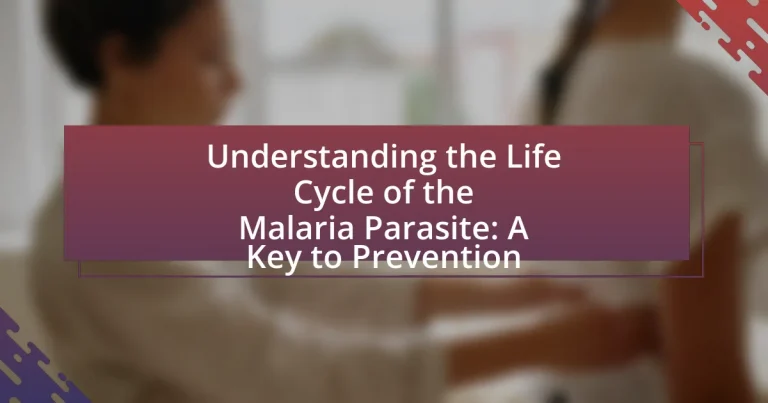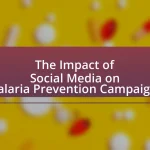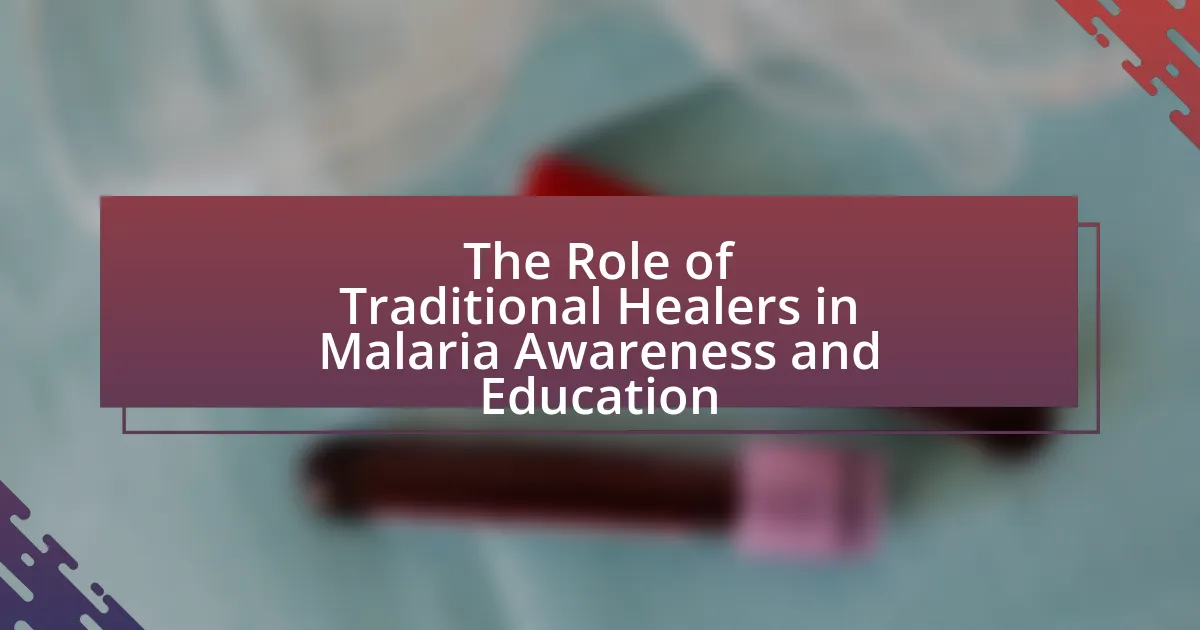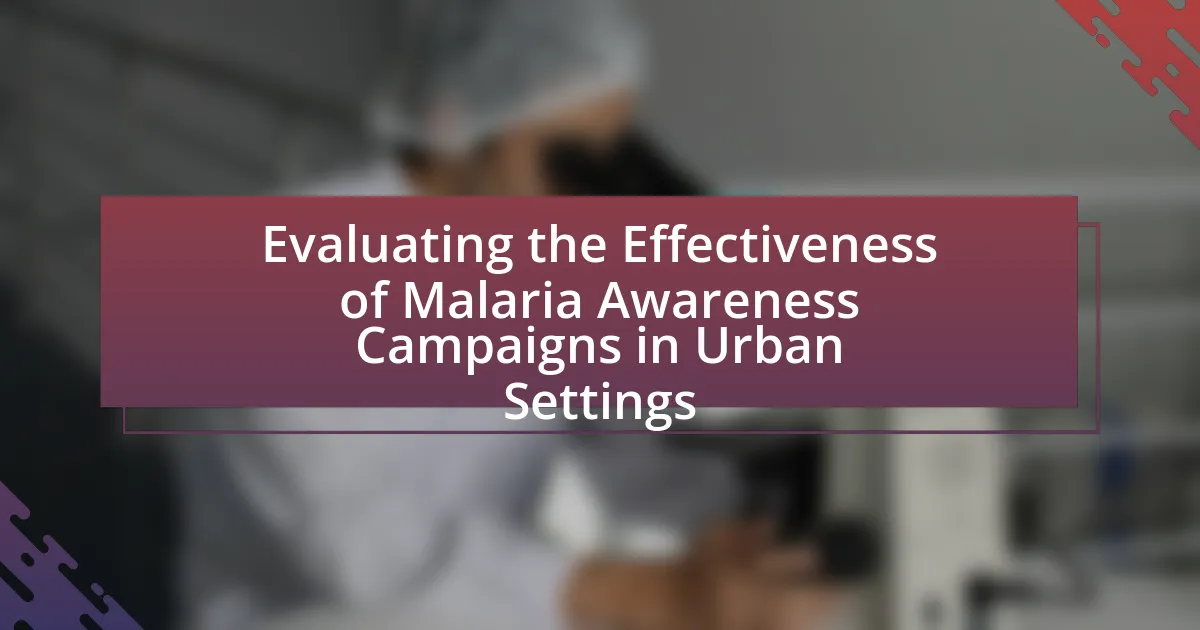The main entity of the article is the life cycle of the malaria parasite, specifically the Plasmodium species. The article provides a detailed overview of the two primary phases of the malaria parasite’s life cycle: the human phase and the mosquito phase, highlighting the stages from sporozoite injection to liver and blood stages. It emphasizes the importance of understanding these stages for effective malaria prevention strategies, including targeted interventions such as insecticide-treated bed nets and antimalarial medications. Additionally, the article discusses the influence of environmental factors on malaria transmission, the implications of sporozoite transmission for public health, and the challenges posed by climate change and drug resistance in controlling malaria.
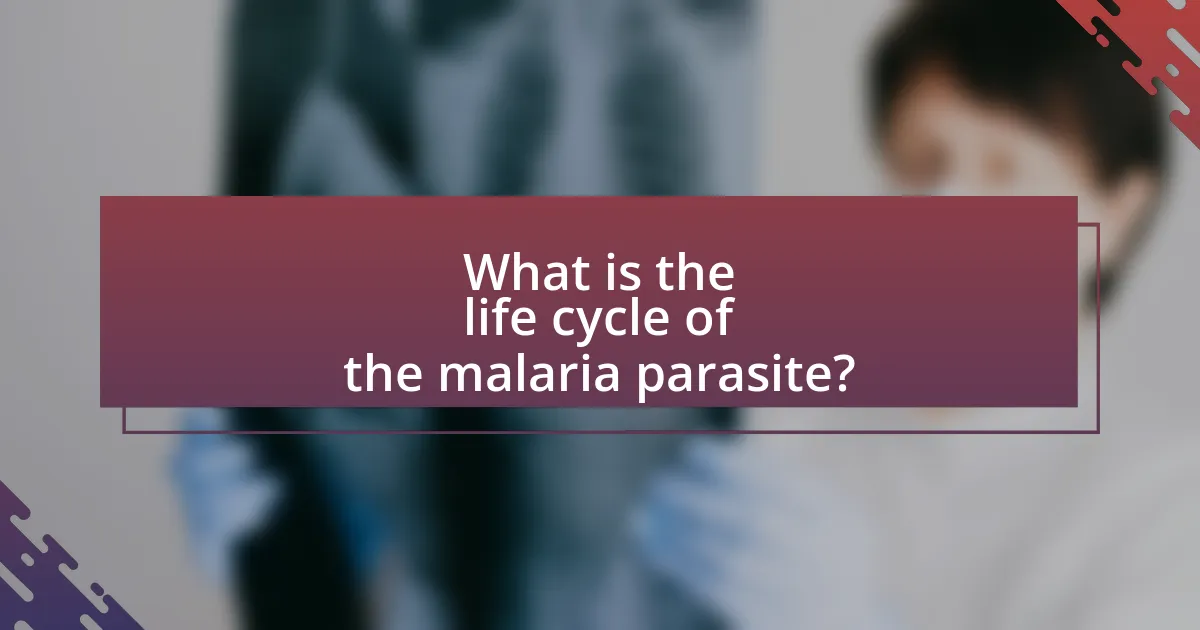
What is the life cycle of the malaria parasite?
The life cycle of the malaria parasite, specifically Plasmodium species, consists of two main phases: the human phase and the mosquito phase. In the human phase, the cycle begins when an infected female Anopheles mosquito bites a human, injecting sporozoites into the bloodstream. These sporozoites travel to the liver, where they mature into merozoites. After a period of replication, the merozoites are released back into the bloodstream, infecting red blood cells and leading to the symptomatic phase of malaria.
In the mosquito phase, when another mosquito bites an infected human, it ingests the gametocytes present in the blood. Inside the mosquito, these gametocytes develop into zygotes and then into sporozoites, which migrate to the mosquito’s salivary glands, ready to infect another human host. This cycle is crucial for the transmission of malaria and understanding it is essential for prevention strategies.
How does the malaria parasite transition between hosts?
The malaria parasite transitions between hosts primarily through the bite of infected female Anopheles mosquitoes. When a mosquito bites a human, it injects sporozoites, the infectious form of the parasite, into the bloodstream. These sporozoites travel to the liver, where they multiply and develop into merozoites. Once released back into the bloodstream, merozoites infect red blood cells, continuing the cycle. This transmission process is crucial for the parasite’s life cycle, as it relies on both the mosquito and human hosts to propagate.
What are the stages of the malaria parasite’s life cycle?
The stages of the malaria parasite’s life cycle include the sporozoite, liver stage, merozoite, gametocyte, and mosquito stage. Initially, the sporozoite stage occurs when an infected Anopheles mosquito bites a human, injecting sporozoites into the bloodstream. These sporozoites travel to the liver, where they develop into liver stage forms. After a period of replication, they release merozoites back into the bloodstream. Merozoites then invade red blood cells, where they multiply and can develop into gametocytes. When another mosquito bites an infected human, it ingests these gametocytes, continuing the cycle. This life cycle is crucial for understanding malaria transmission and prevention strategies.
How do environmental factors influence the life cycle of the malaria parasite?
Environmental factors significantly influence the life cycle of the malaria parasite by affecting the breeding and survival of its mosquito vectors, primarily Anopheles species. Temperature, humidity, and rainfall directly impact the development rate of the malaria parasite within the mosquito, with optimal conditions accelerating the parasite’s maturation. For instance, research indicates that higher temperatures can reduce the time it takes for the parasite to develop from the sporozoite stage to the infective stage, thus increasing transmission rates. Additionally, stagnant water bodies created by rainfall serve as breeding sites for mosquitoes, enhancing their population and, consequently, the likelihood of malaria transmission. Studies have shown that regions with consistent rainfall and warm temperatures experience higher malaria incidence, underscoring the critical role of environmental conditions in the life cycle of the malaria parasite.
Why is understanding the life cycle important for malaria prevention?
Understanding the life cycle of the malaria parasite is crucial for effective malaria prevention because it enables targeted interventions at specific stages of the parasite’s development. The malaria parasite, primarily Plasmodium falciparum, undergoes distinct phases in both the human host and the mosquito vector, Anopheles. By comprehending these phases, public health strategies can be designed to interrupt transmission, such as using insecticide-treated bed nets to prevent mosquito bites during the vector’s active feeding times or administering antimalarial drugs that target the parasite in the human bloodstream. Research indicates that targeted interventions based on life cycle knowledge can significantly reduce malaria incidence; for instance, the World Health Organization reports that countries implementing such strategies have seen up to a 50% decrease in malaria cases.
How can knowledge of the life cycle inform treatment strategies?
Knowledge of the malaria parasite’s life cycle can significantly inform treatment strategies by identifying critical stages for intervention. Understanding that the malaria parasite undergoes distinct phases—such as the sporozoite stage in mosquitoes and the merozoite stage in human hosts—allows for targeted therapies that disrupt these phases. For instance, treatments like artemisinin-based combination therapies (ACTs) are effective against the asexual blood stages of the parasite, while preventive measures like insecticide-treated bed nets target the mosquito stage, thereby reducing transmission. This strategic approach is supported by research indicating that interventions aligned with the life cycle stages can enhance treatment efficacy and reduce malaria incidence, as demonstrated in studies published by the World Health Organization.
What role does the mosquito vector play in the life cycle?
The mosquito vector plays a crucial role in the life cycle of the malaria parasite by facilitating its transmission between hosts. Specifically, female Anopheles mosquitoes ingest the malaria parasite during a blood meal from an infected human. Inside the mosquito, the parasite undergoes development and multiplication, eventually migrating to the salivary glands. When the mosquito bites another human, it injects the parasite, thereby continuing the cycle of infection. This process is essential for the propagation of malaria, as it allows the parasite to move from one human host to another, which is supported by the fact that malaria transmission is primarily dependent on the presence of these specific mosquito vectors.
What are the specific stages of the malaria parasite’s life cycle?
The specific stages of the malaria parasite’s life cycle include the sporozoite stage, liver stage, blood stage, and mosquito stage. Initially, the sporozoites are injected into the human bloodstream by an infected Anopheles mosquito. These sporozoites then travel to the liver, where they invade liver cells and develop into merozoites during the liver stage. After a period of multiplication, the merozoites are released back into the bloodstream, where they infect red blood cells, marking the blood stage. Within the red blood cells, the parasites continue to multiply and can eventually form gametocytes. When another mosquito bites an infected human, it ingests these gametocytes, completing the cycle and allowing the parasite to develop further in the mosquito, which is known as the mosquito stage. This life cycle is crucial for understanding malaria transmission and prevention strategies.
What happens during the sporozoite stage?
During the sporozoite stage, the malaria parasite, specifically Plasmodium, is transmitted to humans through the bite of an infected Anopheles mosquito. Once inside the human bloodstream, sporozoites travel to the liver, where they invade liver cells and undergo asexual reproduction, multiplying into thousands of merozoites. This stage is crucial for the parasite’s development, as it establishes the infection in the host and prepares for subsequent stages in the life cycle, leading to the symptoms of malaria.
How does the sporozoite infect the human host?
The sporozoite infects the human host by being injected into the bloodstream through the bite of an infected female Anopheles mosquito. Once in the bloodstream, sporozoites travel to the liver, where they invade hepatocytes and undergo asexual reproduction, leading to the release of merozoites into the bloodstream. This process is critical for the malaria life cycle, as it marks the transition from the mosquito vector to the human host, facilitating the spread of the disease.
What are the implications of sporozoite transmission for public health?
Sporozoite transmission has significant implications for public health, primarily by facilitating the spread of malaria, a disease that affects millions globally. The transmission occurs when infected Anopheles mosquitoes bite humans, injecting sporozoites into the bloodstream, which then migrate to the liver and multiply. This process leads to the onset of malaria symptoms, contributing to morbidity and mortality rates, particularly in endemic regions. According to the World Health Organization, malaria caused an estimated 627,000 deaths in 2020, highlighting the urgent need for effective control measures. Furthermore, sporozoite transmission complicates malaria eradication efforts, as it requires comprehensive strategies that include vector control, vaccination, and public awareness to reduce mosquito populations and prevent human infections.
What occurs during the liver stage of the malaria parasite?
During the liver stage of the malaria parasite, the sporozoites, which are injected into the human bloodstream by an infected mosquito, migrate to the liver and invade hepatocytes. Within these liver cells, the sporozoites undergo asexual reproduction, transforming into merozoites. This process typically occurs within 5 to 15 days after infection, depending on the species of the malaria parasite. The liver stage is crucial as it allows the parasite to multiply significantly before entering the bloodstream, where it can infect red blood cells and cause the symptomatic phase of malaria.
How does the parasite replicate in the liver?
The malaria parasite, specifically Plasmodium species, replicates in the liver through a process called schizogony. After the parasite enters the bloodstream from a mosquito bite, it travels to the liver, where it infects hepatocytes. Inside these liver cells, the parasite undergoes asexual reproduction, multiplying rapidly to form thousands of merozoites. This replication occurs within a protective vacuole, allowing the parasite to evade the host’s immune response. Once the liver stage is complete, the liver cells burst, releasing the merozoites into the bloodstream, where they can then infect red blood cells, continuing the life cycle of malaria.
What are the potential outcomes of the liver stage for the host?
The potential outcomes of the liver stage for the host include the development of malaria symptoms, the establishment of a chronic infection, or the host’s immune response effectively clearing the infection. During the liver stage, the malaria parasite, specifically Plasmodium species, invades liver cells and can multiply significantly. If the immune system fails to eliminate the parasites, this can lead to the release of merozoites into the bloodstream, resulting in symptomatic malaria. Conversely, a robust immune response may prevent the progression to symptomatic disease, highlighting the critical role of the host’s immune system in determining the outcome of this stage.
What happens during the blood stage of the malaria parasite?
During the blood stage of the malaria parasite, the parasite invades red blood cells, leading to their destruction and the release of toxins. Specifically, the Plasmodium species, which causes malaria, multiplies within the red blood cells, eventually causing them to rupture. This rupture releases merozoites into the bloodstream, which can then infect additional red blood cells. The destruction of red blood cells and the release of toxic substances contribute to the clinical symptoms of malaria, such as fever and anemia. Studies have shown that this stage is critical for the pathogenesis of malaria, as it directly correlates with the severity of the disease and the immune response elicited by the host.
How does the parasite cause symptoms in the human host?
The malaria parasite causes symptoms in the human host primarily through the destruction of red blood cells and the release of toxic substances. When the Plasmodium species infects a human, it enters the bloodstream and invades liver cells, where it multiplies. After a period, the parasites re-enter the bloodstream, infecting red blood cells. The rupture of these cells releases hemozoin, a toxic byproduct of hemoglobin digestion, and other inflammatory mediators, leading to symptoms such as fever, chills, and anemia. Studies have shown that the immune response to these toxins contributes significantly to the clinical manifestations of malaria, including severe complications like cerebral malaria.
What are the mechanisms of immune response during this stage?
The mechanisms of immune response during the malaria parasite’s liver stage primarily involve the activation of T cells and the production of antibodies. When the malaria parasite, specifically Plasmodium spp., enters the liver, it is recognized by dendritic cells, which then present antigens to naïve T cells, leading to their activation. This activation results in the proliferation of CD8+ cytotoxic T lymphocytes that can target infected hepatocytes. Additionally, B cells are stimulated to produce antibodies that can neutralize the parasite and mark it for destruction by other immune cells. Research indicates that this immune response is crucial for controlling the infection and preventing progression to the symptomatic blood stage, as evidenced by studies showing that individuals with robust T cell responses have lower parasitemia levels.
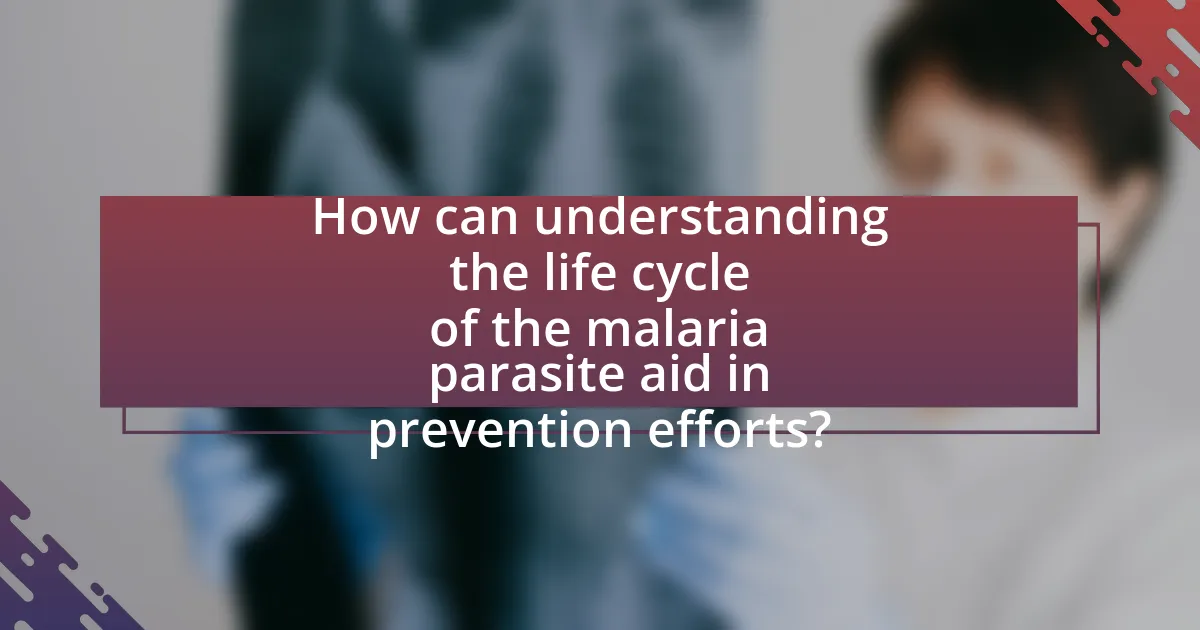
How can understanding the life cycle of the malaria parasite aid in prevention efforts?
Understanding the life cycle of the malaria parasite aids in prevention efforts by identifying critical stages where interventions can be applied. The malaria parasite, primarily Plasmodium falciparum, undergoes a complex life cycle involving both human and mosquito hosts. By comprehending this cycle, public health strategies can target specific phases, such as preventing mosquito bites through insecticide-treated bed nets during the transmission stage or administering antimalarial drugs to humans during the liver stage. Research indicates that targeted interventions can reduce malaria transmission rates significantly; for instance, the World Health Organization reported a 50% decrease in malaria cases in regions where comprehensive vector control measures were implemented. Thus, understanding the life cycle enables effective prevention strategies that disrupt transmission and reduce disease incidence.
What preventive measures can be taken based on the life cycle knowledge?
Preventive measures based on the life cycle knowledge of the malaria parasite include targeting specific stages of the parasite’s development to interrupt transmission. For instance, controlling mosquito populations through insecticide-treated bed nets and indoor residual spraying can significantly reduce the chances of human infection, as the Anopheles mosquito is the vector for malaria. Additionally, eliminating standing water where mosquitoes breed can further decrease their population.
Furthermore, administering antimalarial medications during the peak transmission seasons can protect individuals from infection, especially in high-risk areas. Research indicates that these strategies can lead to a substantial decline in malaria cases, as evidenced by a study published in the Lancet, which found that the use of bed nets reduced malaria incidence by 50% in some regions.
How do insecticide-treated nets impact malaria transmission?
Insecticide-treated nets (ITNs) significantly reduce malaria transmission by providing a physical barrier against mosquito bites and killing mosquitoes that come into contact with the insecticide. Studies show that the use of ITNs can decrease malaria incidence by up to 50% in high-transmission areas. For instance, a systematic review published in the journal “The Lancet” found that ITNs are associated with a substantial reduction in malaria cases and mortality, particularly among children under five years old. This evidence underscores the effectiveness of ITNs as a critical tool in malaria prevention strategies.
What role does vaccination play in malaria prevention?
Vaccination plays a crucial role in malaria prevention by stimulating the immune system to recognize and combat the malaria parasite. The RTS,S/AS01 vaccine, developed by GlaxoSmithKline, has shown efficacy in reducing malaria cases among children in endemic regions, with a reported efficacy of approximately 30% in preventing clinical malaria. This vaccine targets the Plasmodium falciparum parasite, which is responsible for the most severe form of malaria. By providing partial immunity, vaccination can significantly lower the incidence of malaria, thereby reducing morbidity and mortality associated with the disease.
What are the challenges in controlling malaria based on its life cycle?
Controlling malaria is challenging due to the complexity of its life cycle, which involves both human and mosquito hosts. The malaria parasite, primarily Plasmodium falciparum, undergoes several developmental stages in the Anopheles mosquito and the human bloodstream, making it difficult to target all stages effectively. For instance, the parasite’s ability to remain dormant in the liver as hypnozoites complicates treatment and prevention efforts, as standard antimalarial drugs may not eliminate these forms. Additionally, the vector’s resistance to insecticides and the parasite’s resistance to antimalarial medications further hinder control measures. According to the World Health Organization, in 2020, there were an estimated 241 million cases of malaria globally, highlighting the ongoing struggle to manage this disease effectively.
How does resistance to treatment affect malaria control efforts?
Resistance to treatment significantly undermines malaria control efforts by reducing the effectiveness of antimalarial drugs. When malaria parasites develop resistance, standard treatments become less effective, leading to higher rates of morbidity and mortality. For instance, the emergence of resistance to artemisinin, a key component of first-line therapies, has been documented in Southeast Asia, resulting in treatment failures and prolonged illness. This resistance complicates control strategies, necessitating the development of new drugs and treatment protocols, which can be resource-intensive and time-consuming. Consequently, the spread of resistant strains can lead to increased transmission rates, making it more challenging to achieve malaria elimination goals.
What are the implications of climate change on malaria transmission?
Climate change significantly impacts malaria transmission by altering the habitats and behaviors of malaria vectors, primarily Anopheles mosquitoes. Warmer temperatures can expand the geographical range of these mosquitoes, allowing them to thrive in previously inhospitable areas, which increases the risk of malaria outbreaks. For instance, studies have shown that a temperature increase of 1°C can enhance the development rate of the malaria parasite within the mosquito, leading to higher transmission rates. Additionally, changes in precipitation patterns can create more breeding sites for mosquitoes, further facilitating the spread of malaria. These dynamics underscore the critical relationship between climate change and the epidemiology of malaria, highlighting the need for adaptive public health strategies.
What practical steps can individuals take to reduce malaria risk?
Individuals can reduce malaria risk by using insecticide-treated bed nets, applying mosquito repellent, and ensuring proper sanitation. Insecticide-treated bed nets significantly decrease mosquito bites during sleep, as studies show they can reduce malaria transmission by up to 50%. Applying mosquito repellent containing DEET or picaridin on exposed skin can further protect against bites, especially during peak mosquito activity times. Additionally, maintaining clean surroundings by eliminating standing water and using screens on windows and doors can help reduce mosquito breeding sites, contributing to lower malaria risk.
